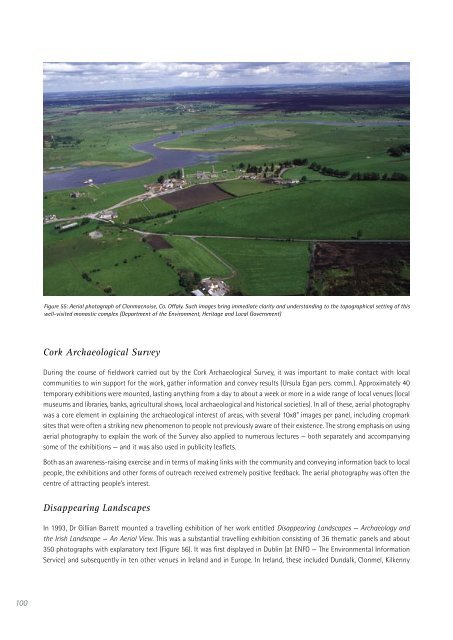Aerial Archaeology in Ireland - The Heritage Council
Aerial Archaeology in Ireland - The Heritage Council
Aerial Archaeology in Ireland - The Heritage Council
You also want an ePaper? Increase the reach of your titles
YUMPU automatically turns print PDFs into web optimized ePapers that Google loves.
100<br />
Figure 55: <strong>Aerial</strong> photograph of Clonmacnoise, Co. Offaly. Such images br<strong>in</strong>g immediate clarity and understand<strong>in</strong>g to the topographical sett<strong>in</strong>g of this<br />
well-visited monastic complex (Department of the Environment, <strong>Heritage</strong> and Local Government)<br />
Cork Archaeological Survey<br />
Dur<strong>in</strong>g the course of fieldwork carried out by the Cork Archaeological Survey, it was important to make contact with local<br />
communities to w<strong>in</strong> support for the work, gather <strong>in</strong>formation and convey results (Ursula Egan pers. comm.). Approximately 40<br />
temporary exhibitions were mounted, last<strong>in</strong>g anyth<strong>in</strong>g from a day to about a week or more <strong>in</strong> a wide range of local venues (local<br />
museums and libraries, banks, agricultural shows, local archaeological and historical societies). In all of these, aerial photography<br />
was a core element <strong>in</strong> expla<strong>in</strong><strong>in</strong>g the archaeological <strong>in</strong>terest of areas, with several 10x8” images per panel, <strong>in</strong>clud<strong>in</strong>g cropmark<br />
sites that were often a strik<strong>in</strong>g new phenomenon to people not previously aware of their existence. <strong>The</strong> strong emphasis on us<strong>in</strong>g<br />
aerial photography to expla<strong>in</strong> the work of the Survey also applied to numerous lectures — both separately and accompany<strong>in</strong>g<br />
some of the exhibitions — and it was also used <strong>in</strong> publicity leaflets.<br />
Both as an awareness-rais<strong>in</strong>g exercise and <strong>in</strong> terms of mak<strong>in</strong>g l<strong>in</strong>ks with the community and convey<strong>in</strong>g <strong>in</strong>formation back to local<br />
people, the exhibitions and other forms of outreach received extremely positive feedback. <strong>The</strong> aerial photography was often the<br />
centre of attract<strong>in</strong>g people’s <strong>in</strong>terest.<br />
Disappear<strong>in</strong>g Landscapes<br />
In 1993, Dr Gillian Barrett mounted a travell<strong>in</strong>g exhibition of her work entitled Disappear<strong>in</strong>g Landscapes — <strong>Archaeology</strong> and<br />
the Irish Landscape — An <strong>Aerial</strong> View. This was a substantial travell<strong>in</strong>g exhibition consist<strong>in</strong>g of 36 thematic panels and about<br />
350 photographs with explanatory text (Figure 56). It was first displayed <strong>in</strong> Dubl<strong>in</strong> (at ENFO — <strong>The</strong> Environmental Information<br />
Service) and subsequently <strong>in</strong> ten other venues <strong>in</strong> <strong>Ireland</strong> and <strong>in</strong> Europe. In <strong>Ireland</strong>, these <strong>in</strong>cluded Dundalk, Clonmel, Kilkenny

















